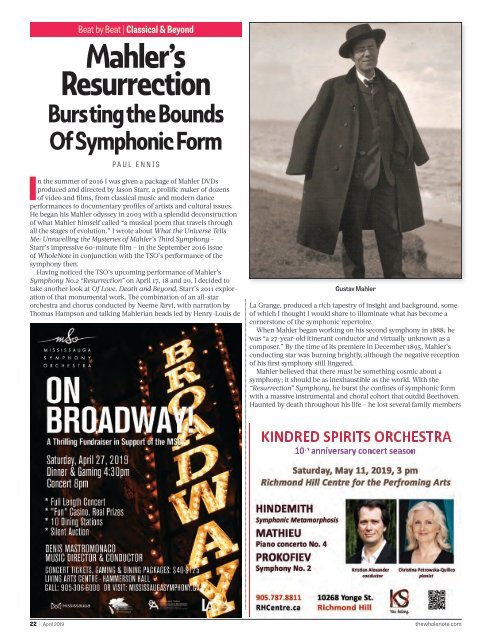Volume 24 Issue 7 - April 2019
Arraymusic, the Music Gallery and Native Women in the Arts join for a mini-festival celebrating the work of composer, performer and installation artist Raven Chacon; Music and Health looks at the role of Healing Arts Ontario in supporting concerts in care facilities; Kingston-based composer Marjan Mozetich's life and work are celebrated in film; "Forest Bathing" recontextualizes Schumann, Shostakovich and Hindemith; in Judy Loman's hands, the harp can sing; Mahler's Resurrection bursts the bounds of symphonic form; Ed Bickert, guitar master remembered. All this and more in our April issue, now online in flip-through here, and on stands commencing Friday March 29.
Arraymusic, the Music Gallery and Native Women in the Arts join for a mini-festival celebrating the work of composer, performer and installation artist Raven Chacon; Music and Health looks at the role of Healing Arts Ontario in supporting concerts in care facilities; Kingston-based composer Marjan Mozetich's life and work are celebrated in film; "Forest Bathing" recontextualizes Schumann, Shostakovich and Hindemith; in Judy Loman's hands, the harp can sing; Mahler's Resurrection bursts the bounds of symphonic form; Ed Bickert, guitar master remembered. All this and more in our April issue, now online in flip-through here, and on stands commencing Friday March 29.
You also want an ePaper? Increase the reach of your titles
YUMPU automatically turns print PDFs into web optimized ePapers that Google loves.
Beat by Beat | Classical & Beyond<br />
Mahler’s<br />
Resurrection<br />
Bursting the Bounds<br />
Of Symphonic Form<br />
PAUL ENNIS<br />
In the summer of 2016 I was given a package of Mahler DVDs<br />
produced and directed by Jason Starr, a prolific maker of dozens<br />
of video and films, from classical music and modern dance<br />
performances to documentary profiles of artists and cultural issues.<br />
He began his Mahler odyssey in 2003 with a splendid deconstruction<br />
of what Mahler himself called “a musical poem that travels through<br />
all the stages of evolution.” I wrote about What the Universe Tells<br />
Me: Unravelling the Mysteries of Mahler’s Third Symphony –<br />
Starr’s impressive 60-minute film – in the September 2016 issue<br />
of WholeNote in conjunction with the TSO’s performance of the<br />
symphony then.<br />
Having noticed the TSO’s upcoming performance of Mahler’s<br />
Symphony No.2 “Resurrection” on <strong>April</strong> 17, 18 and 20, I decided to<br />
take another look at Of Love, Death and Beyond, Starr’s 2011 exploration<br />
of that monumental work. The combination of an all-star<br />
orchestra and chorus conducted by Neeme Järvi, with narration by<br />
Thomas Hampson and talking Mahlerian heads led by Henry-Louis de<br />
Gustav Mahler<br />
La Grange, produced a rich tapestry of insight and background, some<br />
of which I thought I would share to illuminate what has become a<br />
cornerstone of the symphonic repertoire.<br />
When Mahler began working on his second symphony in 1888, he<br />
was “a 27-year-old itinerant conductor and virtually unknown as a<br />
composer.” By the time of its premiere in December 1895, Mahler’s<br />
conducting star was burning brightly, although the negative reception<br />
of his first symphony still lingered.<br />
Mahler believed that there must be something cosmic about a<br />
symphony; it should be as inexhaustible as the world. With the<br />
“Resurrection” Symphony, he burst the confines of symphonic form<br />
with a massive instrumental and choral cohort that outdid Beethoven.<br />
Haunted by death throughout his life – he lost several family members<br />
KINDRED SPIRITS ORCHESTRA<br />
10 th anniversary concert season<br />
22 | <strong>April</strong> <strong>2019</strong> thewholenote.com


















